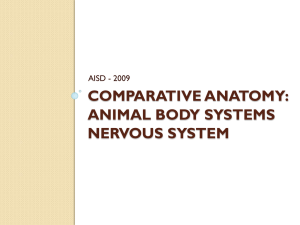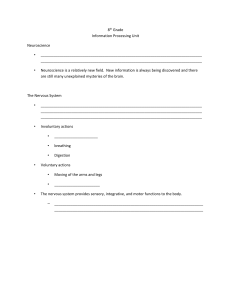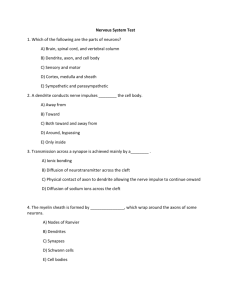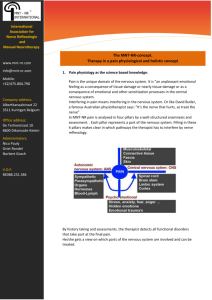nervous tissue worksheet
advertisement
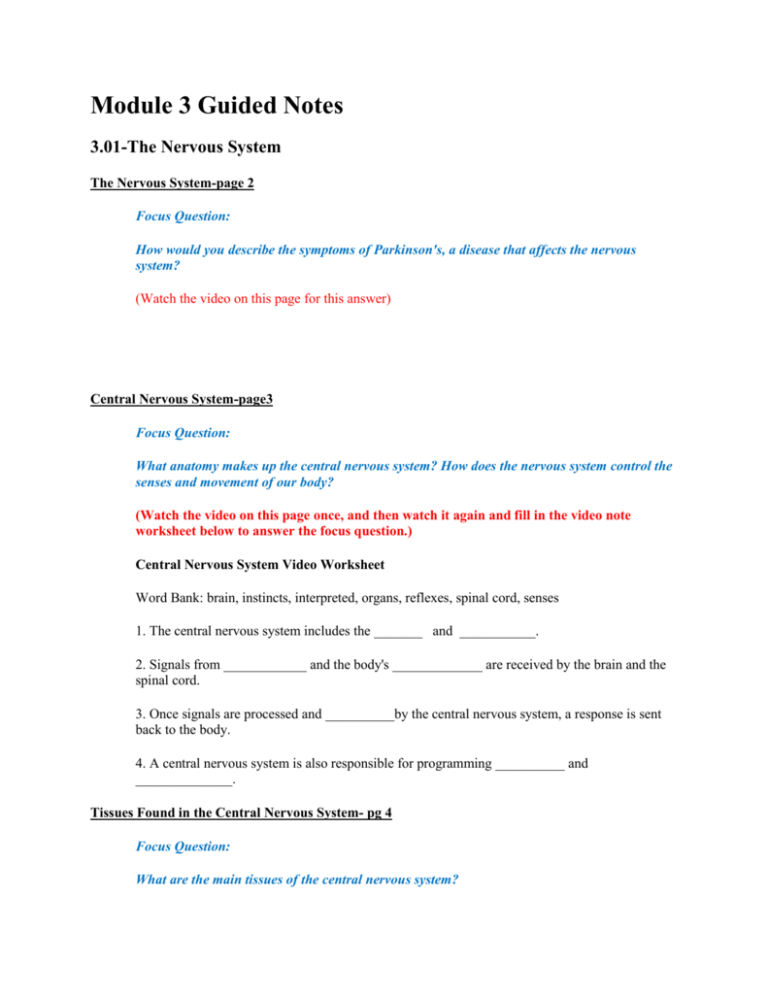
Module 3 Guided Notes 3.01-The Nervous System The Nervous System-page 2 Focus Question: How would you describe the symptoms of Parkinson's, a disease that affects the nervous system? (Watch the video on this page for this answer) Central Nervous System-page3 Focus Question: What anatomy makes up the central nervous system? How does the nervous system control the senses and movement of our body? (Watch the video on this page once, and then watch it again and fill in the video note worksheet below to answer the focus question.) Central Nervous System Video Worksheet Word Bank: brain, instincts, interpreted, organs, reflexes, spinal cord, senses 1. The central nervous system includes the _______ and ___________. 2. Signals from ____________ and the body's _____________ are received by the brain and the spinal cord. 3. Once signals are processed and __________by the central nervous system, a response is sent back to the body. 4. A central nervous system is also responsible for programming __________ and ______________. Tissues Found in the Central Nervous System- pg 4 Focus Question: What are the main tissues of the central nervous system? BrainSpinal CordMeningescerebrospinal fluid (CSF)Describe the 3 layers of the brain: Dura Mater— Arachnoid Mater— Pia Mater— Tissues of the central nervous system-page 5 Focus Question: What is white matter and gray matter? NervesWhite matterGrey matterMyelinInterneuronsNeurons- Peripheral Nervous System-page 6 Focus Question: What is the anatomy of the peripheral nervous system (PNS)? (Watch the video on this page once, and then watch it again and fill in the video note worksheet below to answer the focus question.) Peripheral Nervous System Video Worksheet Word Bank: autonomic, involuntary, parasympathetic, sensory somatic, senses, sympathetic, voluntary, without 1. The peripheral nervous system is divided into two divisions, the ________________ nervous system and the ____________________ nervous system. 2. The sensory somatic nervous system (or SNS) is a _________________ system. It interprets signals received from the ________________ and responds to them. 3. The autonomic nervous system (ANS) is an ________________ system. It acts ______________ our conscious control. 4. The autonomic nervous system (ANS) is further divided into the ______________ and the __________________nervous systems. 5. The ______________________ nervous system prepares the body for emergencies or crisis. 6. The ___________________ system returns the body to normal after an emergency. Nerves of the Peripheral Nervous System-page 7 Focus Question: What are the main nerves of the PNS? Sensory nervesMotor nervesMixed nerves- Assessment Complete the 3.01- The nervous system quiz. 3.02-The Spinal Cord The Spinal Cord-page 2 Focus Question: What are the functions of the spinal cord? It has two important jobs: 1. 2. Define Reflex Arc- Spinal Regions-page 3 and 4 Focus Question: What are the main regions of the spinal cord? Define Spinal nerves(See below for spinal regions) Remember: If the spinal cord is damaged in an accident, the regions below the injury will be disconnected from the brain and the rest of the spinal cord. For example, if a person sustained an injury to the L3 spinal nerve of the lumbar region, all the nerves below that point, and all the body parts linked to them, would stop functioning. Structures of the Spinal Cord-page 5 Focus Question: What are the structures of the spinal cord? (Fill in the blanks from the lesson page) The spinal nerves are attached to the ______________ by two roots: the ____________ dorsal root and the anterior __________ root. The dorsal root is composed of _________ neurons, and the ventral root consists of ________ neurons. The grey matter of the spinal cord consists of _____________. They are unique because they can move signals in both directions, and they are only found in the central nervous system. (Watch the video to learn more about how the interneurons carry messages between sensory and motor nerves. Describe the process below.) How do interneurons carry messages? Reflex Arcs- page 6 Focus Question: How does the spinal cord coordinate our reflexes? Define Reflex- (Use the Knee Jerk Reflex Worksheet below and fill it in as you view the video. Always watch videos once through before filling in the worksheet. It helps to see the anatomy and processes multiple times.) Knee Jerk Reflex (Reflex Arc) Video Worksheet 1. Doctors use a rubber mallet to test the function of your nervous system. They tap the tendon below your kneecap and your leg kick’s out in response. This is a ____________________ reflex. 2. The knee-jerk reflex also works without thinking because reflexes don’t require the ___________________. 3. In a knee-jerk reflex, sensory impulses from the knee tendon are carried to the ____________________. In response, ___________________________ impulses are sent to the muscles of the knee so it kicks out. 4. A _________________________ is the shortest nerve pathway between the spinal cord and a corresponding muscle or gland and usually includes only two or three neurons. 5. The five parts of a reflex arc are a receptor, a ______________ neuron, an _______________, a _______________neuron, and an effector.” 6. A reflex arc starts with a __________________ at the receptor. 7. The impulse moves along a sensory neuron, through the ______________ root. 8. The impulse moves into your spinal cord where it passes to an _____________________. 9. The interneuron processes the signal and sends it through the _________________ root to a motor neuron. 10. The ________________ neuron passes the impulse to one of your muscles or glands to stimulate a response. Assessment Complete the 03.02 The Spinal Cord quiz 3.03-The Brain Regions of the Brain-page 2, 3, 4 Focus Question: What separates the parts of the brain? (page 2) Focus Question: What are the three main regions of the brain? (page 3) Define corpus callosum- 1. Forebrain2. Midbrain3. Hindbrain- Focus Question: Can you identify the major parts of the brain and their functions? (Page 4) Cerebrum- Cerebellum- Cerebral Cortex- Corpus Callosum- Pons- Medulla Oblongata- Thalamus- Hypothalamus- Pituitary Gland- Brain Stem- Frontal Lobe- Parietal Lobe- Occipital Lobe- Temporal Lobe- Assessment Complete the 03.03 The Brain quiz. 3.04-The Parasympathetic and Sympathetic Pathways Autonomic Nervous System-page 2 Focus Question: What are the main differences between the sensory somatic and autonomic nervous systems? The peripheral nervous system is divided into the sensory somatic nervous system and the autonomic nervous system (Use the Chart on the lesson page to fill in the one below) Feature Control Effector organs Number of neurons from the CNS to the effector Effect of nerve impulse on muscle Sensory Somatic Nervous System Autonomic Nervous System Sympathetic Nervous System-page 3 Focus Question: What is the function of the sympathetic nervous system? (Watch the video for the details you need to answer this question. Don’t forget to describe the “Fight or Flight” response.) Parasympathetic Nervous System-page 4 Focus Question: What is the function of the parasympathetic nervous system? The parasympathetic nervous system does the opposite of the sympathetic system. It calms your body after a crisis and reestablishes homeostasis. (Use the Chart on the lesson page to fill in the one below) Effector organ Eye Sweat gland Heart Blood vessels Lungs Gastrointestinal tract Fat cells Sympathetic nervous system Parasympathetic nervous system Nerve Pathways-page 5 Focus Question: What are the nerve pathways of the sympathetic and parasympathetic systems? Stimuli Sensory Neurons Interneurons Preganglionic Motor Neurons Ganglia Postganglionic Motor Neurons Effector organ • SympatheticSpinal ganglia • Parasympatheticcranial ganglia Sympathetic and parasympathetic nerve impulses-page 6 Focus Question: How do sympathetic and parasympathetic nerve impulses differ from one another? A nerve impulse from the sympathetic nervous system enters an organ by a different pathway than an impulse from the parasympathetic nervous system, but a different path doesn't necessarily change the message delivered. It is the neurotransmitter used by each system that explains the different reactions of the organs. NeurotransmitterNorepinephrineAcetylcholine- Assessment Follow the detailed instructions on page 7 of the lesson. Make sure to look the student example and rubric for guidance. 3.05-Nerve Conduction Nerve Conduction-page 3 Focus Question: How are signals sent from the nervous system to other areas and parts of our body? (Use the Signal Transmission Worksheet below and fill it in as you view the video.) Signal Transmission Worksheet Word Bank: action, axons, bridge, impulse, increase, inhibit, membrane, negative, neurotransmitters, one, positive, resting, reverses, synapses, touch 1. A nerve _________________________ is a wave of chemical and electrical charges that move along a neuron. 2. A neuron’s resting state has a ______________________ charge inside and a _________________ charge on the outside. 3. The difference in charge on either side of a nerve cell membrane is referred to as a __________________ potential. 4. The membrane potential in a resting neuron is called a _________________ potential. 5. Nerve impulses occur when electrical charges across a neuron’s cell membrane ________________. 6. An ________________ potential involves the reversal and restoring of the charges across a neuron cell membrane. 7. Nerve impulses move through a cell in _______________ direction. 8. Most neurons do not ___________ each other nor do they touch the organs to which they send messages. 9. Nerve impulses move across spaces called ______________________via specific chemical messages referred to as ___________________________. 10. Special structures located on the ends of _______________ release neurotransmitters into the synapse when an impulse is received. 11. Neurotransmitters act as a _________________ and carry the nerve impulses across the synapse where the impulse is received by the adjacent neuron. 12. Caffeine can ________________ synaptic transmissions, leading to sleeplessness and nervousness. 13. Harmful drugs can _______________ the ability of synapses to function properly. Parts Of A Synapse-page 4 Focus Question: What are the components of a nerve pathway? Nerve pathways include __________ neurons, interneurons, and __________ neurons. These nerve pathways are often referred to as ______________ because they transmit electrical impulses. Neurons create electrical impulses using ____________ potentials. An ___________ potential is a temporary change in electrical potential that occurs between the inside and the outside of a nerve or muscle fiber. It generates a nerve impulse that moves across the axon of a neuron. Once the signal reaches the end of the axon, a chemical called a _____________ moves the signal to the next neuron in the nerve pathway. (Use the Neuromuscular Junction Transmission Worksheet below and fill it in as you view the video.) Neuromuscular Junctions Word Bank: acetylcholine, acetylcholinesterase, axon, dendrite, end plate potential synapse, excite, motor end plate, neurotransmitter, neuromuscular, opens, receptor protein, synaptic vesicles 1. In a neural circuit, the ____________ (sender) of one neuron transmits its impulse to the ___________ (receiver) of another neuron. 2. There is a space called a _______________ between the neurons. 3. The synapse between a neuron and a muscle cell is a __________________ junction. 4. A nerve impulse is passed through to the end of an axon of a motor neuron, which is filled with ____________. 5. When a _______________ is released into the synaptic junction, it bonds to a _______________ on the membrane of a muscle cell. 6. When _________________ bonds with the receptor protein of a muscle cell, it ___________ the sodium and potassium gates of the region at the same time. This small region of the muscle cell is called the _______________. 7. Opening both ion gates at the same time causes an _________________. 8. End plate potentials stimulate adjacent regions of the muscle to create true action potentials that _______________ muscle contraction. 9. In order to prevent the free acetylcholine from reattaching and starting another muscle contraction, the enzyme, _______________________________, deactivates the free acetylcholine. Myoneural Junction- page 5 Focus Question: How are signals sent from the nervous system to other areas and parts of our body? View each of the following nervous system structures using all objective magnifications listed:Spinal Cord, Neuromuscular Junction, and Axon and Axon Terminals. Notice the glial cells, motor neurons, myelin sheaths, axons, and axon terminals, which are labeled on the slides. NERVOUS TISSUE WORKSHEET As you view the tissue slides, draw your observations in the space provided. Include any written notes that may be helpful when you are studying and preparing for your assignment. Tissue Slide Spinal Cord 1X Central Canal 4X Dorsal Horns 4X Ventral Horns 4X Dorsal Root 4X Ventral Root 4X Glial Cell in Dorsal Horn 20X Observations Neuromuscular Junction 10X Neuromuscular Junction 40X Axon and Axon Terminals 40X Assessment Follow the detailed instructions on page 6 of the lesson. Make sure to look the student example and rubric for guidance. (You can also diagram this process, if materials for developing a model are not available.) 3.06-Senses Our Bodies Senses-page 2 Focus Question: What are sensory organs and how do they work? (View the video on the page for details for this Focus Questions) Sensory Organs and Functions-page 3 Focus Question: How do the structures of the sense organs relate to their functions? (Use the Sense Organ Worksheet below and fill it in as you view the video.) Sense Organ Worksheet Word Bank: back, brain, camera, central nervous system, cochlea, cochlear , contracts, ear drum, fumes, interprets, iris, olfactory, olfactory bulbs, optic, ossicles, pinna , pressure, pupil, retina, taste buds, temperature, vibrates 1. Smells can be ______________ or vapors. 2. They travel into your nasal cavity which is lined with millions of ______________ sensors. 3. These sensors are nerve cells that convert the chemical message of the smell to a nerve impulse that travels through the skull to the ________________which send the message to the brain. 4. The largest papillae are on the__________ of your tongue. 5. All papillae have taste receptor cells which are bundled together. We often call these bundles____________. 6. When a flavor hits the taste buds, they send a nerve impulse to your brain that _______________ the flavor. 7. Your eye acts like a _________________. 8. The _____________ is the colored part of your eye and the __________ is the black portion. 9. The iris ______________ and relaxes to control the amount of light coming in and it focuses the light on the lens behind the pupil to form the image. 10. Then the lens focuses an upside down image onto the___________ in the back of your eye. 11. The retina converts the light to nerve impulses that travel through your _________ nerve to your brain. 12. Your ______________ turns the image right-side up again. 13. Sound waves enter your ear through the _________ and travel through the ear canal to your _________in the middle of your ear. 14. When the wave hits the ear drum it __________. 15. Vibration travels through the three tiniest bones in the human body, called the ___________, to the cochlea. 16. The ___________ has tiny cilia inside it that vibrate when the sound wave reaches them from the ossicles. 17. The vibration stimulates the ___________ nerve which sends the signal to the brain. 18. There are tactile nerve receptors in the skin that sense ____________, vibrations, _________________, and pain. 19. The information gathered by receptors is transported to the ________________which analyzes it and orders a reaction. Assessment Complete the Lab worksheet from page 4. 3.07-The Endocrine System The Endocrine System-page 2 Endocrine systemHormonesFocus Question: What is the difference between endocrine and exocrine? Endocrine- Exocrine- Endocrine System-page 3 Focus Question: How is the nervous system different from the endocrine system? Glands-page 4 Focus Question: What are the main glands of the endocrine system and what hormones do they secrete? (Be sure to use the Endocrine Gland Video Worksheet below to take notes as you view the video.) Word Bank: anterior, behind, calcitonin, glucagon, insulin, parathyroid, parathyroid hormone, pancreas, pineal, posterior, center, endorphins, growth hormone, increases, lymphocytes, melatonin, pituitary, sight, sleep, smell, sound, taste, temperature, thymus, thymosin, thyroid, thyroid hormone, trachea, renin, blood pressure, erthypoietin, adrenal glands, cortisol, medulla, norepinephrine, ovaries, testes, progesterone, androgens 1. The hypothalamus is located near the __________________ of the brain. 2. The hypothalamus receives chemical and nervous input about____________________________________________ ___________________________________________________________and blood glucose concentration. 3. The hypothalamus controls the ________________________ gland. 4. The pituitary gland has two parts the anterior and the ______________________________. 5. The ________________ part of the pituitary gland releases_________________________________ which stimulates bone and muscle growth. It also releases ________________________________ which reduce the perception of pain. 6. The _________________________ gland is located __________________________ the hypothalamus. 7. The pineal gland receives information about light and dark cycles and it releases ___________________________ which assists with ____________________ cycles. 8. The ____________________ gland is a butterfly shaped structure located in front of the _____________________. 9. The thyroid gland releases _____________________ which plays a critical goal in development and growth. It also _________________ the body’s metabolic rate and releases _________________________ which lowers blood calcium. 10. The ____________________ glands are located to either side of the thyroid. They release ______________________ which raise blood calcium levels. 11. The _________________gland is located in the chest region. It releases ___________________ a chemical that activates __________________ which assist the immune system with fighting off infection. 12. The _____________________ is located beneath the stomach. It releases two hormones: _______________ and __________________. 13. The hormone _____________________ lowers your blood glucose levels. 14. The hormone _____________________ raises your blood glucose levels. 15. The two kidneys are located below the rib cage produce_____________________ a hormone that regulates __________________ . The kidneys also release __________________________ which stimulates red blood cell production. 16. The _________________________ glands sit above the kidneys. 17. The ___________________ cortex of the adrenal glands release _____________________ . 18. The ____________________of the adrenal glands release _____________________ and ______________________. 19. Epinephrine and __________________________ are hormones that are released during periods of stress. The help regulate the fight or flight response. 20. The gonads are the __________________ in woman and the ___________________ in men. 21 The _________________ produce estrogens and ____________________ in women. 22. The _________________ produce _________________________ in men. Assessment Follow the detailed instructions on page 5 of the lesson. Make sure to look the student example and rubric for guidance. 3.07 Honors-Hormones Hormones-page 2 Focus Question: How do hormones affect target cells and tissues? Endocrine glands make two different types of hormones: ___________ and _____________. This video describes each type of hormone and how they affect target cells. (Be sure to use the “Hormones and how they work” Video Worksheet below to take notes as you view the video.) Word bank: lipoproteins, hydrophilic, receptor, signal 1. Hormones are divided into two chemical groups. What are they? 2. Which hormone group includes all of the sex hormones (estrogen, progesterone, and testosterone) and hormones from the adrenal cortex (cortisol and vitamin D)? 3. What hormone group includes proteins such as insulin and growth hormones? 4. What biological molecule forms steroid? 5. Why are steroid molecules hydrophobic? 6. In order for lipids to move through water based fluids, they must combine with proteins to form ________________________. 7. Non-steroid hormones dissolve in water so they are ________________________________. 8. Hormones act on target cells. How does a hormone recognize a target cell? 9. All steroid hormones can pass through the cell membranes but non-steroid cannot pass through. Why? 10. What do non-steroid hormones need in order to pass through a cell membrane? 11. What happens after a non-steroid hormone attaches to a receptor protein of a cell membrane? 12. The same hormone can affect different cells in different ways because each cell has its own unique _______________ proteins. 13. Once a hormone has attached to a signal protein or entered a cell, _______________ transduction occurs. The Functions of Hormones-page 3 Focus Question: Which hormones are active during puberty and how do they function during adolescence? (View the video for guidance on this focus question.) Assessment Follow the detailed instructions on page 4 of the lesson. Make sure to view the Questions and Grading Checklist button.



